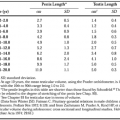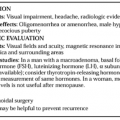GRAVES DISEASE IN SPECIAL SITUATIONS
Part of “CHAPTER 42 – HYPERTHYROIDISM“
PREGNANCY AND GRAVES DISEASE
The diagnosis of thyrotoxic Graves disease in a pregnant patient is especially difficult, because euthyroid pregnant women may share many signs and symptoms considered indicative of hyperthyroidism, including nervousness, irritability, warm skin, hand tremor, palmar erythema, diaphoresis, goiter, widened pulse pressure, and fatigue.83 No signs or symptoms are absolutely discriminatory of the thyrotoxic state, but clinical emphasis should
be placed on (a) an inability to gain weight normally while pregnant; (b) a firm thyroid gland weighing more than 40 g and which may demonstrate a bruit; (c) a prior history of Graves disease; and (d) ophthalmopathy with conjunctivitis, chemosis, or proptosis. The total serum T4 level rarely increases to higher than 20 μg/dL in euthyroid pregnant women, and the serum free T4 level should not be elevated. TSH receptor antibodies should not be detectable in a euthyroid pregnant woman. The proper interpretation depends on whether binding inhibition or stimulatory assays are performed. Stimulatory TSH receptor antibodies are more supportive of the diagnosis of thyrotoxic Graves disease, whereas positive binding inhibition assays may indicate Graves disease or autoimmune thyroid disease but not necessarily hyperthyroidism. The laboratory evaluation of a pregnant woman should not entail exposure to isotopes or radiation. The use of third-generation TSH assays preclude the necessity of performing a TRH assay in most patients.
be placed on (a) an inability to gain weight normally while pregnant; (b) a firm thyroid gland weighing more than 40 g and which may demonstrate a bruit; (c) a prior history of Graves disease; and (d) ophthalmopathy with conjunctivitis, chemosis, or proptosis. The total serum T4 level rarely increases to higher than 20 μg/dL in euthyroid pregnant women, and the serum free T4 level should not be elevated. TSH receptor antibodies should not be detectable in a euthyroid pregnant woman. The proper interpretation depends on whether binding inhibition or stimulatory assays are performed. Stimulatory TSH receptor antibodies are more supportive of the diagnosis of thyrotoxic Graves disease, whereas positive binding inhibition assays may indicate Graves disease or autoimmune thyroid disease but not necessarily hyperthyroidism. The laboratory evaluation of a pregnant woman should not entail exposure to isotopes or radiation. The use of third-generation TSH assays preclude the necessity of performing a TRH assay in most patients.
Moderate to severe thyrotoxic Graves disease in a pregnant woman requires treatment. If it is difficult to distinguish between euthyroidism or mild thyrotoxicosis, the decision to treat with antithyroid medications is more difficult, because mild thyrotoxicosis in some instances may pose less of a risk to the mother and fetus than the administration of antithyroid medications.84,85
Thyrotoxicosis often improves during pregnancy, and antithyroid medication dosages may be less than those required during the nonpregnant state. Occasionally, however, thyrotoxicosis may be severe and difficult to control. It is important to render these women euthyroid, but it is also important not to administer very large PTU or MMI doses, because the antithyroid medications cross the placenta and can cause fetal goiter or hypothyroidism. The author believes there is greater confidence and experience with the use of PTU than with MMI during pregnancy and so consider it the agent of choice. Furthermore, MMI has been reported to cause aplasia cutis, a scalp condition in neonates. The infant’s thyroid function should be checked immediately after birth and probably again in 1 to 2 months. Although some complications occur, in general, antithyroid agents do not appear to be highly teratogenic.85,86 and 87 PTU doses of <300 mg per day and MMI doses of <30 mg per day rarely seem to have adverse effects on the fetus. In one study, the neonatal malformation rate was higher in thyrotoxic mothers than in euthyroid mothers, and the restoration of maternal euthyroidism with the use of antithyroid medication had a beneficial effect in decreasing the frequency of the malformations.85 There was no correlation between MMI dose and the frequency or type of malformation. Thus, uncontrolled hyperthyroidism in the mother may be a more important factor in causing malformations than the antithyroid drugs themselves.
It is believed the pregnancy itself may decrease the immunologic responses involved in causing Graves disease, and, commonly, improvement or even remission occurs during pregnancy. Unfortunately, however, after delivery the Graves disease often relapses.
The therapeutic goal is clinical euthyroidism, a serum T4 level within the normal range for pregnancy (i.e., 10 to 16 μg/dL),84 and a normal free T4. It is preferable to monitor free T4 and T3 when observing a hyperthyroid pregnant patient. On the other hand, if larger doses of PTU or MMI are necessary to restore the euthyroid state, or if the condition cannot be well controlled with antithyroid medications, surgical thyroidectomy then becomes a treatment option and is optimally performed in the second trimester.79,83,88 A patient with uncontrolled or poorly controlled thyrotoxicosis should usually be monitored closely for 1 to 2 weeks before thyroidectomy to ensure compliance with medications. Because of the brief period involved, daily doses of PTU of as much as 600 mg (or 60 mg of MMI) may need to be given for a very short time preoperatively. The addition of stable iodine for 7 days or less may be necessary if the thyrotoxicosis is extremely poorly controlled. Extreme caution must be exercised, because iodides, especially when given for longer periods, may cause massive enlargement of the fetal thyroid gland, resulting rarely in asphyxiation. Management of a pregnant Graves disease patient who is severely hyperthyroid should be performed by physicians familiar with this condition. Similarly, thyroidectomy should not generally be undertaken unless an experienced surgeon and anesthesiologist are available and the patient is in nearly a euthyroid condition (see also Chap. 110).
When the use of a β-adrenergic blocker is deemed necessary in a pregnant patient with Graves disease, propranolol is preferred because of the extensive experience with this agent.83,84,86,87,88 and 89 Although propranolol is generally safe, intrauterine growth retardation and fetal bradycardia have been associated with its use. Hence, propranolol should be reserved for severely thyrotoxic pregnant subjects and used judiciously, with careful monitoring of the patient and fetus.
The measurement of serum TSH receptor antibody is indicated in most pregnant patients with Graves disease, with or without active thyrotoxicosis. A maternal level of stimulatory TSH receptor antibody more than five times higher than control in the third trimester accurately predicts neonatal thyrotoxicosis.88 If the titer is very high, the fetus is monitored closely, and the neonate is carefully examined at birth, with determination of serum iodothyronines and TSH levels. An apparently euthyroid infant should nevertheless be monitored closely for the development of thyrotoxicosis during the first 3 months of life (see Chap. 47). There is no safe and effective method of treating a thyrotoxic fetus in utero, although this has been done successfully in one reported case.89
Stay updated, free articles. Join our Telegram channel

Full access? Get Clinical Tree






